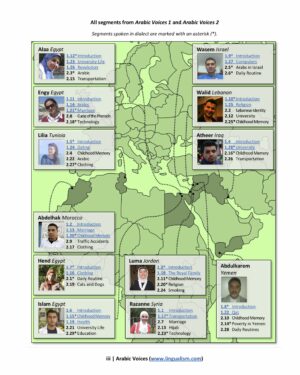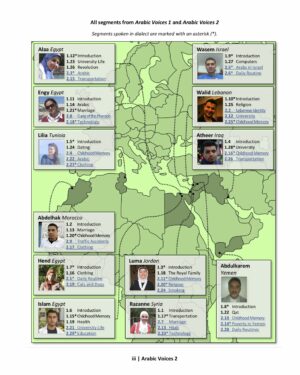Home » Modern Standard Arabic » Clothing–Hend
Clothing–Hend
| Greetings! [00:00] | السلام عليكم ورحمة الله وبركاته. | |
| Welcome to a new Arabic Voices video. [00:02] | أهلاً ومرحبًا بكم في فيديو آخر من فيديوهات Arabic Voices. | |
| I'm Mustafa Ahmed. [00:06] | معكم مصطفى أحمد. | |
| Today we are going to talk about what Hend had to say about clothes, the latest fashion, what men wear, and what women wear in Egypt. [00:09] | اليوم سنتحدّث عمّا قالته هند بشأن الملابس، وآخر صيحات الموضة، والزي الذي يرتديه الرجال، والزي الذي ترتديه النساء في مصر. | |
| We will comment on some of the words she used, and on different grammatical forms. [00:22] | وسنقوم بالتعليق على بعض ما استخدمته من كلمات، ومن صياغة نحوية مختلفة. | |
| So, let's start on page 87. Hend says specifically on line 2, "The higher classes are keen on acquiring the latest fashions." [00:30] | فهيا بنا نبدأ في الصفحة السابعة والثمانون—تقول هند تحديدًا في السطر الثاني: (فالطبقات الأعلى تحرص على اقتناء آخر صيحات الموضة). | |
| Hend says she is keen on acquiring the latest fashion. She mentions the verb يحرص [be keen on] here, or the verb whether you use it in the present or the past. [00:35] | تقول هند تحرص على اقتناء آخر صيحات الموضة؛ تذكر أن الفعل [يحرص] هنا أو الفعل إذا استخدمته في المضارع أو الماضي | |
| If you use it in general, you must use the preposition على with it. يحرصوا على for the higher classes are keen to acquire the latest fashion. [01:01] | إذا ما استخدمته عامةً فلا بدّ أن تستخدم معه حرف الجر [على]، [يحرصوا على] فالطبقات الأعلى تحرص على اقتناء آخر صيحات الموضة. | |
| I'm keen on learning; he's keen on money, and so on... or to make money, and so on. [01:15] | أنا أحرص على التعلم، هو يحرص على المال، وهكذا... أو على جني المال، وهكذا. | |
| If you use the verb يحرص (be keen), you must use the preposition على. [01:24] | فإذا استخدمت الفعل [يحرص] فلا بدّ أن تستخدم معه حرف الجر [على]. | |
| Great! After that, Hend says, "The higher classes are keen on acquiring the latest fashions. آخر صيحات الموضة [the latest trends in fashion] is a term which means that... [01:32] | عظيم! بعد ذلك تقول هند: (فالطبقات الأعلى تحرص على اقتناء آخر صيحات الموضة)؛ [آخر صيحات الموضة] هذا مصطلح وهو يعني أن.. | |
| this class wants to acquire the most valuable things, and… I mean, the latest types of clothes… the latest types of clothes. [01:45] | هذه الطبقة تريد اقتناء أثمن الأشياء، و… يعني أحدث أنواع الملابس… أحدث أنواع الملابس، | |
| The latest fashion' is a term that means that this class wants to acquire the latest types of clothes in the market. [01:57] | فآخر صيحات الموضة هو مصطلح يعنيأن هذه الطبقة تريد اقتناء أحدث أنواع الملابس في السوق. | |
| For example: if an artist or singer wears a certain outfit, then this outfit becomes the latest fashion, so many people, especially the rich, are keen to acquire these clothes. [02:06] | فمثلًا: إذا ارتدى فنان ما أو مغنًى ما زيًا ما، فيصبح هذا الزي هو آخر صيحات الموضة، فيحرص كثير من الناس خاصةً الأغنياء منهم، يحرصون على اقتناء هذه الملابس. | |
| It is the latest fashion, and as we explained, it is the latest type of clothing in the market: 'high fashion.' [02:25] | هي آخر صيحات الموضة، وهي كما شرحنا أحدث أنواع الملابس في السوق [آخر صيحات الموضة]. | |
| In the third sentence... or on line 3, Hend says, "while the middle class is satisfied with imitating these brands." As I saw here, Hend used a word that is borrowed from the English language and used in the Arabic language. [02:38] | في الجملة الثالثة أو في السطر الثالث—تقول هند: (بينما تكتفي الطبقة المتوسطة بتقليد تلك الماركات) كما رأيت هنا هند استخدمت كلمة هي كلمة مستعارة من اللغة الإنجليزيةوتستخدم في اللغة العربية. | |
| We want to point out here that there are many Arabized words, and the Arabized words were borrowed from another language, such as English or German, and so on, and then used as an Arabic word. [03:01] | ونريد الإشارة هنا إلى أن هناك العديد من الكلمات التي تم تعريبها، والكلمات التي تم تعريبها هي أُستعارت من اللغة لغة أخرى كاللغة الإنجليزية أواللغة الألمانية وهكذا، ثم تم استخدامها كأنها كلمة عربية. | |
| The plural is even forms as if it's an Arabic word. So, the word الماركات (brands) here is a word borrowed from the English language مارك (brand, mark) in the British dialect or in the American dialect. [03:20] | ويتم جمعها كذلك على أنها كلمة عربية، فكلمة [الماركات] هنا هي كلمة مستعارة من اللغة الإنجليزية [مارك] باللهجة البريطانية أو باللهجة الأمريكية [مارك]. | |
| And this is a word borrowed from this... from the English language and has been Arabized, so it becomes the word... it becomes... It is even used in the Arabic plural. [03:35] | وهذه كلمة مستعارة من هذه… من اللغة الإنجليزية وتم تعريبها فتصبح كلمة... فتصبح... فتستخدم حتى في الجمع بالصيغة العربية. | |
| I think you know other examples, such as the word كمبيوتر (computer) for example, this is borrowed from the English language as well. [03:53] | وأظن أنك تعرف أمثلة أخرى مثل: كلمة [كمبيوتر] مثلًا فهذه مست… مستعارةمن اللغة الإنجليزية كذلك. | |
| The word تليفون (telephone) is also borrowed from the English language. [04:03] | وكلمة [تليفون] هي مستعارة كذلك من اللغة الإنجليزية. | |
| After its Arabization, the language becomes... ... the word becomes as if it is in Arabic, so the plural becomes as if we are combining a word in Arabic, like brands, and so on. [04:09] | وبعد تعريبها تصبح اللغة... تصبح الكلمة وكأنها بالعربية فنقول: [تليفون تليفونات] فيصبح الجمع وكأنها وكأننا نجمع كلمة باللغة العربية [فالماركة الماركات] وهكذا. | |
| Great! We then move on to what Hend said on line 5. Hend says, "Where they prefer the cheapest clothes the cheapest price." [04:27] | عظيم! ننتقل بعد ذلك إلى ما قالته هند في السطر الخامس—تقول هند: (حيث يفضلون الملابس الأرخص سعرًا الأرخص) | |
| Here Hend compares the clothes owned by the poor class with other clothes. [04:44] | فهند هنا تقارن الملابس التي تقتنيها الطبقة الفقيرة بالملابس الأخرى. | |
| She says that this... these clothes are the cheapest. [04:53] | فتقول أن هذا... هذه الملابس هي الأرخص سعرًا. | |
| For comparison, here Hend uses what we know as a 'superlative أفعل form,' so the أفعل form is used for comparison. [04:59] | للمقارنة تستخدم هنا هند ما نعرفه بأفعل [أفعل التفضيل] فصيغة أفعل تستخدمها للمقارنة. | |
| You are comparing two things, or comparing one thing and many things, using what we know in a more active form. [05:10] | أنت تقارن بين شيئين أو تقارن بين شيء وأشياء كثيرة فتستخدم ما نعرفه بصيغة أفعل. | |
| رخيص (cheap) is the adjective, so the word cheap is transformed into an أفعل form, so it becomes أرخص (cheaper/cheapest). This garment is cheap—this garment is the cheapest of all the [cheapest] garments, in the form أفعل, as they prefer the cheapest garments. [05:19] | رخيص هي الصفة فتحول كلمة رخيص إلى صيغة أفعل فتصبح [أرخص]؛ هذا الثوب رخيص—هذا الثوب أرخص من جميع الثياب [أرخص] على وزن أفعل، حيث يفضلون الملابس الأرخص سعرًا. | |
| You are comparing a house with other houses, and you say, "This is a big house, and this is the largest house." (big, bigger/biggest), (cheap, cheaper/cheapest). [05:43] | أنت تقارن بين بيت وبيوت أخرى فتقول: (هذا بيت كبير وهذا هو البيت الأكبر) [كبير أكبر] [رخيص أرخص]. | |
| For example, you say, "This car is beautiful, but this car is more beautiful." [05:57] | تقول مثلًا: (هذه السيارة جميلة، ولكن هذه السيارة الأجمل أو هذه السيارة أجمل). | |
| If you use أجمل (more beautiful) only without the definite article الـ, you can use it to compare one car with one other car, [06:08] | إذا استخدمت [أجمل] فقط بدون الألف واللام فيمكنك أن تستخدمها للمقارنة بين سيارة واحدة وسيارة أخرى واحدة، | |
| but if you use the the definite article الـ, it often means that this car is better than all the others and the MOST beautiful in... than all the other cars, in your opinion. [06:18] | ولكن إذا استخدمت الألف واللام فغالبًا ما تعني أن هذه السيارة هي الأفضل من جميع السيارات الأخرى والأجمل في... من جميع السيارات الأخرى في رأيك. | |
| This car is beautiful; this car is the most beautiful. This house is big; this house is the biggest, and so on, in the أفعل form. [06:30] | (هذه السيارة جميلة، هذه السيارة الأجمل)- (هذا البيت كبير، هذاالبيت الأكبر) وهكذا في صيغة أفعل. | |
| Great! We then move on to what she said on line 9. Hend says, "The degree of compliance with these conditions of the veil varies among girls," and she uses the word [الالتزام] (abiding). [06:43] | عظيم! ننتقل بعد ذلك إلى ما قالته في السطر التاسع—تقول هند: (تختلف درجة الالتزام بتلك الشروط للحجاب بين الفتيات)، فتستخدم هنا كلمة [الالتزام]. | |
| When using the word الالتزام (abiding), you must follow it with the preposition بـ. [06:59] | ولا بدّ عند استخدام كلمة [الإلتزام] أن تلحقها بحرف الجر [باء]. | |
| She says, "I abide by the law; I abide by the conditions" and so on. [07:06] | فتقول: (ألتزم بالقانون، ألتزم بالشروط) وهكذا. | |
| When you use this word, either as a verbal noun or the verb يلتزم [to abide], you must use the preposition بـ (by) with it. [07:15] | فعندما تستخدم كلمة [الإلتزام] سواء في المصدر، أو تستخدم الفعل [يلتزم]؛ لا بدّ أن تستخدم معه حرف الجر [الباء]. | |
| I abide by the law; abide by the conditions; abide by the rules, and so on. [07:27] | (ألتزم بالقانون، الإلتزام بالشروط، الإلتزام بالقواعد) وهكذا. | |
| Great ! We then move on to the last point, which is on line 13. Hend says, "But rather, some of them resort to… some of them compensate for covering their heads by exaggerating their appearance or their makeup." [07:37] | عظيم ! ننتقل بعد ذلك إلى آخر نقطة، وهي في السطر الثالث عشر—تقول هند: (بل تلجأ بعضه… بعضهن إلى تعويض تغطيتهن لرؤوسهن عن طريق المبالغة في مظهرهن أو تبرجهن). | |
| Here, Hend uses بل (but rather) to connect what she says with what she said before. [07:59] | فتستخدم هند هنا [بل] للربط بين ما تقوله وما قالته من قبل. | |
| And this conjunction is used when you say something that contradicts what you said before. You say something in the negative first, and then you say something in the affirmative; Something negated then affirmative. [08:07] | وأداة الربط هذه تُستخدم عندما تذكر شيء يناقض ما قلته من قبل، أنت تذكر شيء في النفي أولًا، ثم بعد ذلك تذكر شيء في الإثبات؛ شيء منفي بعد ذلك الإثبات. | |
| For example, here Hend says, "While their clothes do not reflect any of the conditions of Islamic dress, some women even resort to replacing their headscarves." [08:28] | فمثلًا هنا هند تقول: (بينما لا تعكس ملابسهن أيًا من شروط الزي الإسلامي، بل تلجأ بعضهن إلى تعويض تغطيتهن لرؤوسهن). | |
| So you mention something in the negative, then after that, you mention it in the affirmative. For example, you say, "I am not listening to music, but I am watching the video). The first is in the negative, and the second is in the affirmative. [08:42] | فتذكر شيء في النفي ثم بعد ذلك تذكره في الإثبات فمثلًا تقول: (أنا لا أسمع الموسيقى، بل أشاهد الفيديو) الأولى في النفي والثانية في الإثبات. | |
| "I'm not wasting my time, rather I'm working." And so, she says, for example, "I'm not playing, rather I'm studying..." "I'm not playing, rather I'm studying." [08:59] | (أنا لا أضيّع وقتي، بل أنا أعمل) وهكذا، تقول مثلًا (أنا لا ألعب، بل أنا أذاكر... أنا لا ألعب، بل أنا أذاكر). | |
| As you saw, the first sentence is in the negative, and we use لا [not] in... in the negative of the present tense. [09:16] | كما رأيت الجملة الأولى في النفي ونستخدم [لا] في... عند نفي المضارع، | |
| "I am not listening to music, rather I'm studying," for example. And the second part of the sentence in the affirmative. Negative then affirmative when you use the conjunction بل. [09:25] | (أنا لا أستمع إلى الموسيقي، بل أنا أذاكر مثلًا) والجزء الثاني من الجملة في الإثبات؛ النفي ثمالإثبات عند استخدامك لأداة الربط [بل]. | |
| Great! And that was the last point we wanted to comment on about what Hend had said. [09:43] | عظيم! وهذه كانت آخر نقطة نريد التعليق عليها بشأن ما قالته هند. | |
| Until next time and another video, when we comment on what Arabic speakers use. [09:51] | إلى لقاءٍ آخر، وفيديو آخر نقوم بالتعليق على ما يستخدمه متحدّثو اللغة العربية. | |
| I thank you very much for listening. Take care, God willing. May God’s peace, mercy, and blessings be upon you. [10:00] | وأشكركم شكرًا جزيلًا لاستماعكم، و ألقاكم على خير بإذن الله، السلام عليكم ورحمة الله وبركاته. |
Video Lessons
Arabic Voices MSA Lessons
Arabic teacher Mostafa Ahmed takes us through segments in MSA from Lingualism's book Arabic Voices 1: Authentic Listening and Reading Practice in Modern Standard Arabic and Colloquial Dialects, explaining interesting points of grammar and vocabulary.










